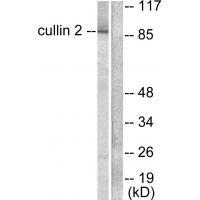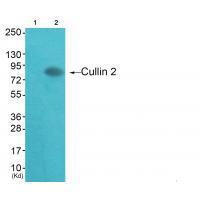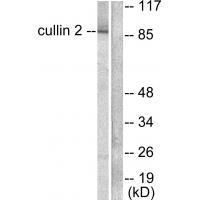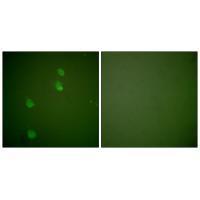



| WB | 咨询技术 | Human,Mouse,Rat |
| IF | 咨询技术 | Human,Mouse,Rat |
| IHC | 1/50-1/100 | Human,Mouse,Rat |
| ICC | 1/100-1/500 | Human,Mouse,Rat |
| FCM | 咨询技术 | Human,Mouse,Rat |
| Elisa | 咨询技术 | Human,Mouse,Rat |
| Aliases | Cullin-2; CUL-2; |
| Entrez GeneID | 8453; |
| WB Predicted band size | 82,84kDa |
| Host/Isotype | Rabbit IgG |
| Antibody Type | Primary antibody |
| Storage | Store at 4°C short term. Aliquot and store at -20°C long term. Avoid freeze/thaw cycles. |
| Species Reactivity | Human |
| Immunogen | Synthesized peptide derived from human Cullin 2. |
| Formulation | Purified antibody in PBS with 0.05% sodium azide. |
+ +
以下是关于 **Cullin 2抗体** 的3篇参考文献及其简要摘要:
---
1. **文献名称**: *"Cullin-RING ubiquitin ligases in regulation of the hypoxia-inducible factor pathway"*
**作者**: Guo J, et al.
**摘要**: 该研究探讨了Cullin 2(CUL2)作为支架蛋白在缺氧诱导因子(HIF)泛素化降解中的作用,利用Cullin 2抗体验证其与VHL蛋白复合体的结合,揭示了其在肾癌细胞中的调控机制。
2. **文献名称**: *"Structural basis for VHL-mediated ubiquitylation of HIF-1α by the CUL2-RBX1 complex"*
**作者**: Hon WC, et al.
**摘要**: 通过X射线晶体学和Cullin 2抗体的免疫共沉淀技术,阐明了CUL2-RBX1复合体与VHL蛋白协作识别并泛素化HIF-1α的结构基础,为靶向HIF通路的癌症治疗提供依据。
3. **文献名称**: *"Cullin 2 regulates Zebrafish vascular development through modulation of VEGF signaling"*
**作者**: Pierce SB, et al.
**摘要**: 研究利用斑马鱼模型和Cullin 2抗体敲降技术,发现CUL2通过调控VEGF信号通路影响血管生成,揭示了其在胚胎发育中的关键作用。
---
以上文献均涉及Cullin 2抗体的实验应用(如免疫沉淀、Western blot等),并聚焦于其在泛素化、癌症或发育生物学中的功能。
Cullin 2 (CUL2) is a core component of the Cullin-RING ubiquitin ligase (CRL) family, which plays a critical role in the ubiquitin-proteasome system by targeting specific proteins for degradation. As a scaffold protein, CUL2 assembles into multi-subunit E3 ligase complexes, most notably the von Hippel-Lindau (VHL) tumor suppressor complex. This complex regulates hypoxia-inducible factor-1α (HIF-1α) degradation under normoxic conditions, linking CUL2 to cellular responses to oxygen levels, angiogenesis, and tumorigenesis. Dysregulation of CUL2-mediated ubiquitination is implicated in cancers, developmental disorders, and other diseases.
CUL2 antibodies are essential tools for studying its expression, interactions, and function. They are widely used in techniques like Western blotting, immunoprecipitation, and immunofluorescence to detect CUL2 protein levels, assess post-translational modifications (e.g., neddylation), or map its binding partners (e.g., VHL, Elongin B/C). Both monoclonal and polyclonal antibodies targeting specific epitopes or domains (e.g., N-terminal or C-terminal regions) are available. Researchers often validate these antibodies using knockdown/knockout controls or recombinant protein overexpression to ensure specificity. Given CUL2's role in cellular homeostasis and disease, its antibodies are pivotal in exploring mechanisms of ubiquitination, hypoxia signaling, and therapeutic targets in cancer biology.
×